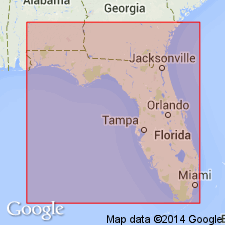
- Usage in publication:
-
- Lake City limestone
- Modifications:
-
- Named
- Dominant lithology:
-
- Limestone
- AAPG geologic province:
-
- South GA-North FL sedimentary province
Summary:
Name applied to limestone facies of early middle Eocene in northern FL and the peninsula. Made up of alternating layers of dark-brown and chalky limestone with gypsum or chert present in some wells and in Cosden's Lawson well No. 1, Marion Co., a 25-ft bed of lignite. Lateral gradational lithologic change from limestone facies of the peninsula into clastic facies, which contains a fauna related to that of Cook Mountain formation of Claiborne age is noted in wells from Wakulla Co. west to Walton Co. Starting as highly glauconitic chalky limestone, the rock becomes increasingly sandy until it develops into chalky glauconitic sand. Normally 400 to 500 ft thick in Tallahassee area. In Pierce Co., GA, and southern part of peninsula, 200 to 250 ft. In north FL and north half of peninsula, underlies Tallahassee limestone (new) and equivalent nonfossiliferous limestone. Along northeast coast and in south half of peninsula, underlies Avon Park limestone (new). In west FL, where late middle Eocene beds are not definitely known to be present, early middle Eocene clastic facies of Cook Mountain age underlies Ocala limestone; overlies lower Eocene unit. Oldsmar limestone (new), Avon Park limestone, Tallahassee limestone (with its equivalent nonfossiliferous facies), and Lake City limestone represent Claiborne group in peninsular FL, and where all three units are present they appear to be a conformable sequence.
Source: GNU records (USGS DDS-6; Reston GNULEX).
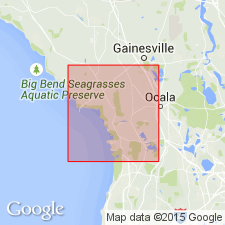
- Usage in publication:
-
- Lake City limestone
- Modifications:
-
- Overview
- Areal extent
- Revised
- AAPG geologic province:
-
- Florida platform
Summary:
In Claiborne group. As used by Applin and Applin (1944), Lake City limestone is predominantly chalky to granular limestone, containing chert and gypsum in some areas. The limestone grades laterally into clastic facies in series of wells extending from Wakulla Co. westward to Walton Co. In practice, the Lake City is commonly identified from its fauna, the top being marked by first appearance of DICTYOCONUS AMERICANUS (Cushman) and as thus used it was faunal zone. Recently, present writer has found, particularly in Citrus and Levy Cos., that formation was lithologic unit having diagnostic lithologic characteristics as well as distinct fauna. Formation characterized by several lithologies which probably occur as thin beds in thick carbonate section. These beds include a pseudo-oolite, a brown to coffee-colored chert, a bentonitic(?) clay, and a brownish-gray laminated finely crystalline dolomite containing seams of black carbon and flattened decalcified specimens of FABULARIA VAUGHANI, COSKINOLINA sp., ARCHAIAS COLUMBIAENSIS, and larger VALVULINIDAE giving it a mottled and laminated appearance. Occasionally last mentioned rock is seamed with peat and not fossiliferous. Applin and Applin assigned 411 ft of dolomite in Florida Oil Discovery-Sholtz well, Levy Co., to the nonfossiliferous limestone [lying between the Lake City and Avon Park], but it is herein considered dolomitized Lake City limestone and included in that formation. Thickness in wells in Levy and Citrus Cos. 575 to 923 ft.
Source: GNU records (USGS DDS-6; Reston GNULEX).
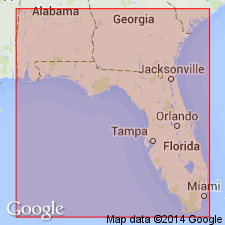
- Usage in publication:
-
- Lake City†
- Modifications:
-
- Abandoned
- AAPG geologic province:
-
- South Georgia sedimentary province
- Florida platform
Summary:
In subsurface, middle Eocene Avon Park Limestone changed to Avon Park Formation and stratigraphically extended to include the underlying Lake City Limestone, now abandoned in both south GA and peninsular FL. Units cannot be distinguished from each other on the basis of either lithology or fauna. Avon Park retained because it was described on an earlier page in original report for both units, and traditionally it has been applied to rocks whose lithology is different from the overlying Ocala Limestone.
Source: GNU records (USGS DDS-6; Reston GNULEX).
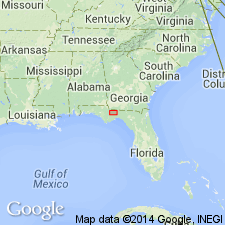
- Usage in publication:
-
- Lake City
- Modifications:
-
- Not used
- AAPG geologic province:
-
- South Georgia sedimentary province
Summary:
Avon Park Formation includes the middle Eocene carbonates that occur in northern and peninsular FL. [Miller (1986) grouped the lithologically similar Avon Park and Lake City Limestones of Applin and Applin (1944) into a single unit and that nomenclature is followed here.]
Source: GNU records (USGS DDS-6; Reston GNULEX).
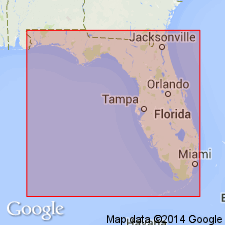
- Usage in publication:
-
- Lake City
- Modifications:
-
- Not used
- AAPG geologic province:
-
- Florida platform
Summary:
Author follows revisions of Miller (1986) and accepts the abandonment of the Lake City and the stratigraphic extension of the Avon Park Formation. The identity of the Lake City of Applin and Applin (1944) was based on the presence of certain Foraminifera at the top and base. These fossils were subsequently found in both underlying and overlying formations.
Source: GNU records (USGS DDS-6; Reston GNULEX).
For more information, please contact Nancy Stamm, Geologic Names Committee Secretary.
Asterisk (*) indicates published by U.S. Geological Survey authors.
"No current usage" (†) implies that a name has been abandoned or has fallen into disuse. Former usage and, if known, replacement name given in parentheses ( ).
Slash (/) indicates name conflicts with nomenclatural guidelines (CSN, 1933; ACSN, 1961, 1970; NACSN, 1983, 2005, 2021). May be explained within brackets ([ ]).

